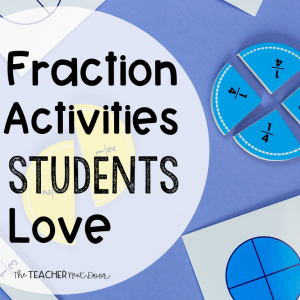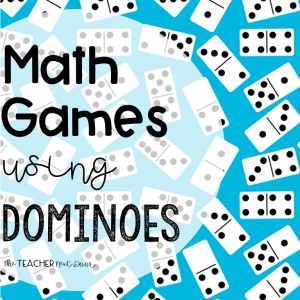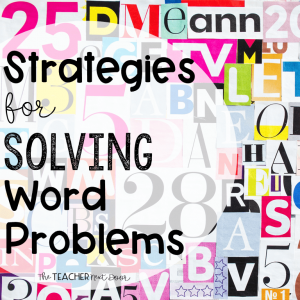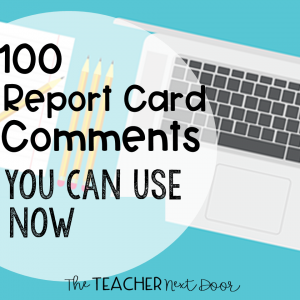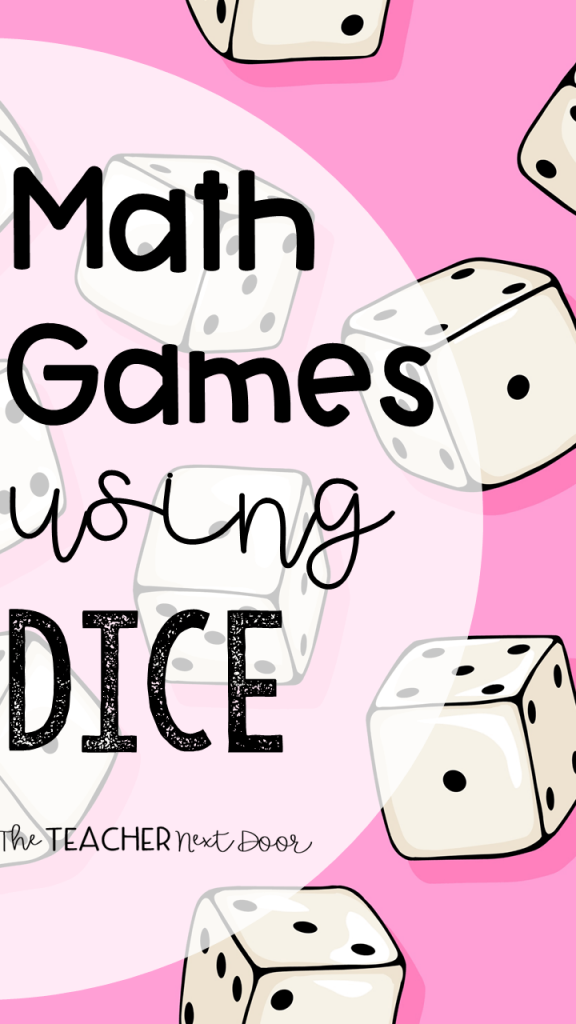
Games are an important part of math class, in my opinion.
Not only are kids able to practice the skills that we have been focusing on (over and over repeatedly), but they are also doing it in a format that they find fun…and anything that adds fun to learning is a plus in my book!
This post contains Amazon Affiliate links. If you purchase through one of these links, The Teacher Next Door, LLC receives a few cents on the dollar. This commission directly supports us as a small business and ensures that we can continue to create high-quality content for upper elementary teachers, like yourself! As always, the products shared are tried, true, and tested. Enjoy!
So, when I plan my math lessons, I am always on the lookout for hands-on fun activities that will add variety and motivation to our math time. For that reason, these dice games are some of my go-to games.
If you’re looking for hands-on dice at an affordable price, here’s my favorite set from Amazon. The best thing about this set is that it comes in 5 colors. This makes making groups easy!
Don’t forget about storing your dice too! Using individual dice containers keeps them from getting lost. Simply put a die (or two) in each container and you’re guaranteed to never lose one under the cabinets in your classroom again. I like this set here and this fun, colorful set here.
Btw…Did you know if you type “dice roller” into Google, you’ll have a digital (and silent) dice manipulative for your students to use whether you’re teaching in the classroom or virtually?
Here are the dice-based math games, listed by category:
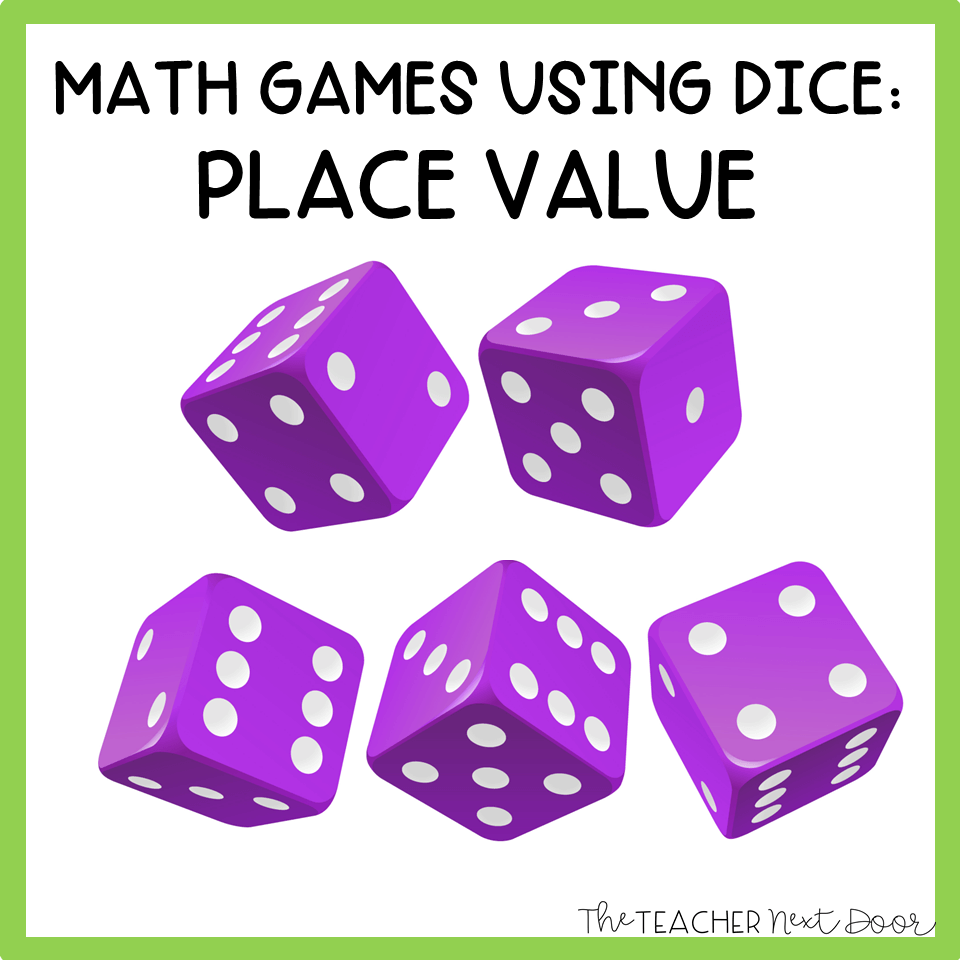
1. Build it Big or Build it Small
Kids each need a dice and some scratch paper or a whiteboard. Tell the kids whether they are trying to make a larger or a smaller number. I usually start big but after 5 minutes, switch it to small for variety. Kids make dashes on their paper/whiteboard to indicate the place value of the number.
So, if you’re working on hundreds, kids would make 3 dashes, 4 for thousands, and so on. Kids take turns rolling dice the same number of times as the dashes. Each time a person rolls, he/she must think logically to place the number shown on the dice, on the dashes.
For example, if you are working on a large number and roll a six, it would go on the largest place value space but if you were working on making a small number, it would go on the smallest place value space.
Once kids have placed a number, it can not be moved. The person with the highest (or lowest, depending upon the game’s goal) wins a point.
Variation 1: Make this a decimal place value game by having the kids draw a decimal before the dashes.
Variation 2: My favorite way to play math games with playing cards or with dice is to give each set of partners a “more/less” coin that I make ahead of time. This is a simple plastic or foam circle and I attach a sticker (or you could use sharpie) on one side with the word “more” and the other side with the word “less”. That way at the end of the game, no one knows who has won until you flip the more/less coin.
If more is shown, the higher number wins and if less is shown, the smaller number wins. I like this because it adds suspense to the game and because no one feels the need to poop out/give up before the game is over if it becomes obvious that there is no chance for winning.
2. Roll and Round That Number
For this game, kids need scratch paper or a whiteboard, as well as a set of dice. The number of dice used should match whatever place value you are working on. So if you’re focusing on hundreds, partners need three, or for ten thousands, partners need five.
The first person rolls all three dice at the same time and builds a number with it. The second person does the same and then each person rounds his/her number to the highest place value. For example, a roll of 5, 3, 7 could make the number 753, which would be rounded to 800. Students compare rounded numbers and the highest correctly rounded number wins (or use the more/less coin to decide).
Variation 1: Give the kids a certain number of dice and tell them how to round them. Change that every few minutes. For example, if partners have 5 dice, tell them to round it to the nearest ten. After five minutes, tell them on their next game to round it to the nearest hundred…
Variation 2: This can also be a decimal rounding game.
Variation 3: For older kids, you could use this with positive/negative numbers. Make a coin like the more/less coin with a positive or negative sign on it to flip and then round and compare numbers.
3. Order of Operations
Kids definitely need scratch paper or whiteboards for this game. Partners should have 3 or more dice, depending upon the type of math sentence template you give them. You’ll need to give kids a specific template that will work, as not all templates will work for this game using the numbers on the dice (see a few examples below).
Have the kids make a template on their paper/whiteboards. Kids roll the dice and place the numbers on the template provided. Kids solve that problem, using the order of operations and then compare their number to see who has the largest (and correctly done) number to determine a winner.
A few possible templates for this game:
_ _ + (_ – _) = Example with 4 dice: 25 + (6 – 4) = 23
(_ x __) + _ = Example with 3 dice: (3 x 4) + 2 = 14
_ _ – ( + _) = Example with 4 dice: 26 – (5 + 3) = 18
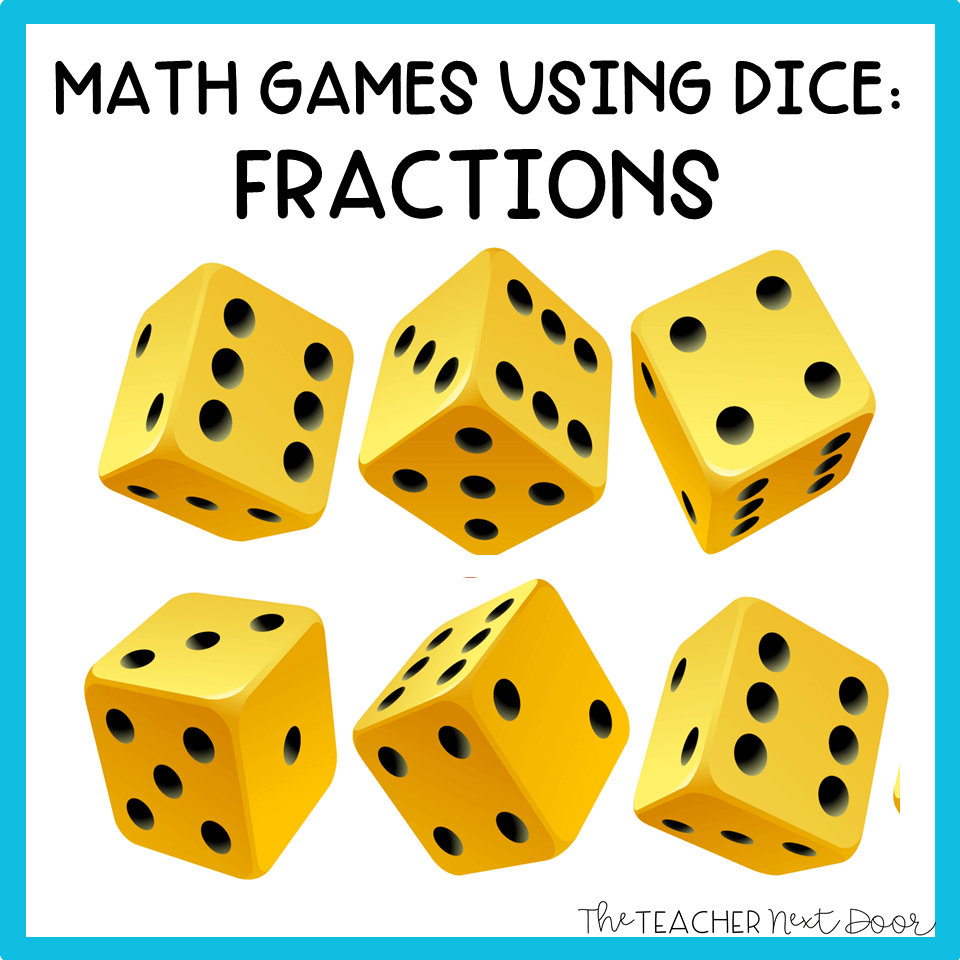
4. Fraction War
Have kids use scratch paper or whiteboards. Partners each roll two dice to make a fraction. The smaller of the roll should go on top/be the numerator. If the person rolls doubles (same number twice, like two fives), that person automatically wins a point for that round. Once dice are rolled, partners work together to see which fraction is larger. The larger fraction wins.
Variation 1: Once dice are rolled, the person who determines the largest fraction correctly the fastest, wins the point.
Variation 2: Use the more/less coin to determine the winner, once fractions are compared.
Variation 3: Add or multiply the fractions and the person who correctly determines the sum/product first wins.
5. Simplify Fractions
Using scratch paper or whiteboards and three dice, partners each roll the dice to create a fraction. One of the numbers is placed on top (unless it is a one, which means the fraction can’t be simplified) and the other two numbers are left side by side to create the denominator.
For example, if the roll is 4, 3, 6…The fraction might be 4/36, which simplifies to 1/9 or it could be 6/34, which simplifies to 3/17. If the roll does not allow for simplifying, the person automatically loses. The person who has the largest fraction wins.
Variation 1: Use the more/less coin to determine a winner
Variation 2: Kids who can come up with the most ways to make fractions to simplify would win. This would be a higher-level thinking kind of activity.
6. Improper Fraction Challenge
For this game, scratch paper or whiteboard will be needed, as well as three dice per partners or small groups. Each person rolls the 3 dice and makes an improper fraction by placing two of the dice side by side as the numerator and the other dice as the denominator, and then simplifies to make a whole number or a mixed number.
For example, if the child rolled 2, 4, 5…Some possible fractions would be 24/5 = 4 4/5… or 54/2 = 27… or 45/2 = 22 1/2. The higher-level thinking comes in as kids are trying to make the largest number possible.
Variation 1: Kids use the same numbers to convert into a whole number/mixed number.
Variation 2: Older kids may use 5 dice (3 for numerators and 2 for denominators).
Variation 3: Use the more/less coin to determine a winner.
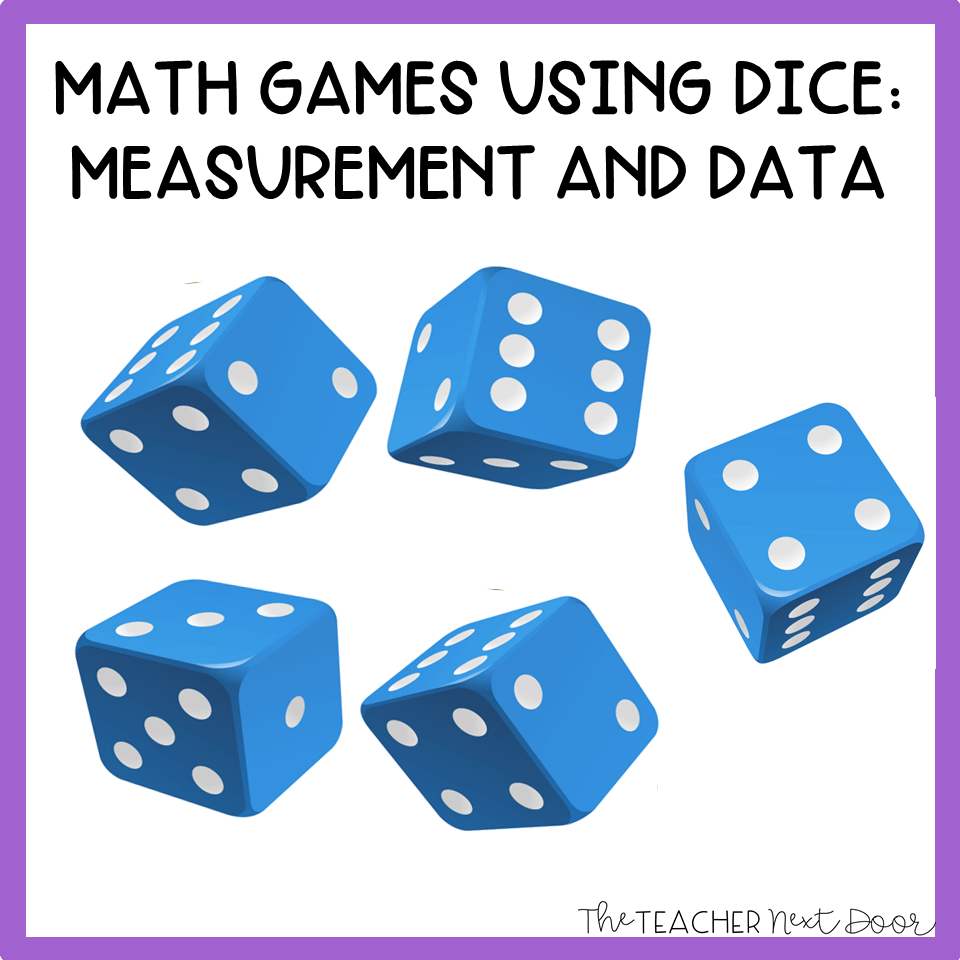
7. Line Plots
Here’s a hands-on way for kids to get lots of practice making line plots. For this game, kids need scratch paper or a whiteboard and 2 – 5 dice per small group. Each child makes a template of a line plot before starting the game. Kids need a line and numbers one to six like this:
____________________________
1 2 3 4 5 6
Each person rolls a total of 10 times. Each child creates a line plot using the numbers shown on the dice. So, for example, if a child rolled 1, 1, 2, 2, 3, 3, 3, 4, 5, 6…the line plot would look like this:
X
X X X
X X X X X X
1 2 3 4 5 6
Once each person has a line plot made, one person rolls the dice. The number shown determines who wins. For example, if a 3 was rolled, the person in the example above has three in the 3 sections.
That would be compared to the partner’s section 3 and the person with more in that particular section wins. If it is the same, the dice is rolled again until a winner is determined.
8. Area and Perimeter
For this game, students need two dice and a piece of grid paper for partners to share. Each student also needs a marker or a crayon/colored pencil. Partners should have different colors, so if one has red, the other might be blue.
Each person rolls the dice and uses the numbers as the length and width of a rectangle. The person draws the rectangle on the grid paper to scale. So if 4 and 6 were rolled, the person would draw a rectangle that is 4 squares wide by 6 squares long.
In the rectangle, that person writes the perimeter or the area (whichever the teacher indicates at the beginning of the game). The other person takes a turn and the winner is the player who has captured the most area on the grid paper, when time is called.
Variation 1: Use two separate pieces of grid paper. Once students determine area (or perimeter) keep a running total of points. For example, if the area was ten and the second area was 6, the running total would be 16. Highest score at the end wins.
Variation 2: If studying colonization, each player may choose a country and imagine that the grid paper is land in the New World. Spain, England, France, the Netherlands and other countries would work well in this scenario.
Hope this has given you a few ideas for dice games. If you’re looking for more engaging resources, I also have some awesome task cards for 3rd grade, 4th grade, and 5th grade, that are great for centers, one on one or for a whole class game of scoot:
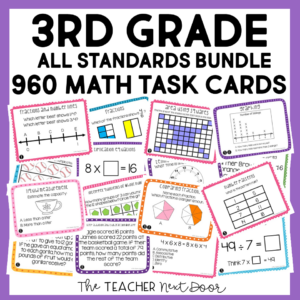
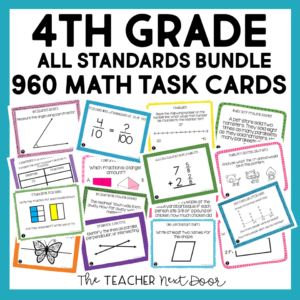
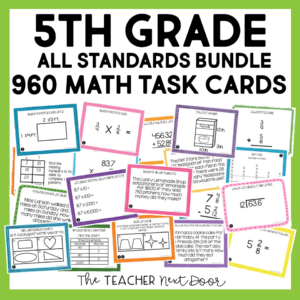
Finally, if you would like more free math game ideas, here are a few other posts you might like:
Click here to read Math Games Using Playing Cards.
Click here to read Math Games Using Dominoes.
Thanks so much for stopping by!


